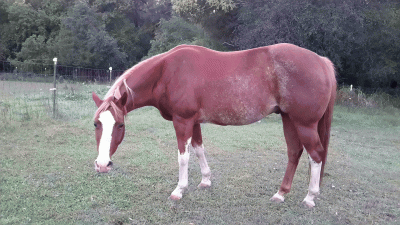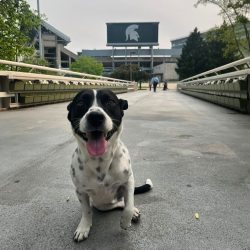Meet Treat! Treat is a 14-year-old Appaloosa gelding who came to us after he continued to show signs of colic, despite medical management on the farm.

Upon presenting to Michigan State University Veterinary Medical Center, Treat was found to have a gas distended large colon and a suspected displacement. Despite intensive medical therapy overnight, he continued to colic and was taken to surgery the following morning due to persistent pain.
In surgery, Treat was found to have a very large sand impaction in his large colon, which had also caused a significant amount of gas to build up behind the sand and a displacement. In surgery, we were able to remove the sand and correct the displacement. The sand impaction had already caused some damage to his colon; luckily, we got to it just in time.
Treat developed ileus post operatively. When a horse develops this complication, their small intestine stops moving appropriately and fluid backs up into the stomach. When fluid backs up in the stomachs of dogs, cats, and humans, we vomit. However, horses cannot vomit and their stomachs must be emptied with a nasogastric tube. Ileus can be a challenging complication to manage. Luckily, Treat’s owner was dedicated to him and after several days of intensive care he was able to get back on the right track again … and back home just in time for Christmas!
Clinical Notes
Sand can be a serious problem for horses in Michigan. Horses can ingest sand when they are eating grass, hay, or spilled grain out in the field. Although many supplements are available to decrease the amount of sand in your horse’s gastrointestinal tract, the best way to prevent sand colic is to prevent them from eating it in the first place! We recommend placing mats underneath their eating areas (under hay, hay racks, and where grain is fed). This way, when feed is dropped on the ground, they wont pick up sand with their feed.
Many owners are familiar with the “glove test” for sand. This is where some of your horse's manure is suspended in water in a rectal sleeve and then assessed to see if sand settles out. Unfortunately, this is not a reliable indicator of the volume of sand that may be in your horse’s colon, as sand may settle in the colon and only be passed intermittently. Signs of a large amount of sand accumulation in the colon include intermittent diarrhea and intermittent signs of colic. The only way to know for sure if your horse has a significant amount of sand that has accumulated in their colon (other than finding it in surgery) is to take an abdominal radiograph (X ray), which allows us to see the sand.
If you are worried that your horse may have a problem with sand, please contact us. We can schedule an appointment to evaluate your horse for sand and to discuss management options to try to minimize the risk.
Dr. Jamie Kopper, DVM, PhD, is a resident in Large Animal Internal Medicine and Emergency/Critical Care at the MSU Veterinary Medical Center.

